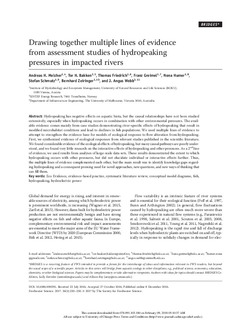| dc.contributor.author | Melcher, Andreas | |
| dc.contributor.author | Bakken, Tor Haakon | |
| dc.contributor.author | Friedrich, Thomas | |
| dc.contributor.author | Greimel, Franz | |
| dc.contributor.author | Humer, Nona | |
| dc.contributor.author | Schmutz, Stefan | |
| dc.contributor.author | Zeiringer, Bernhard | |
| dc.contributor.author | Webb, J. Angus | |
| dc.date.accessioned | 2018-05-28T12:39:18Z | |
| dc.date.available | 2018-05-28T12:39:18Z | |
| dc.date.created | 2016-12-15T15:08:16Z | |
| dc.date.issued | 2017 | |
| dc.identifier.citation | Freshwater Science. 2017, 36 (1), 220-230. | nb_NO |
| dc.identifier.issn | 2161-9549 | |
| dc.identifier.uri | http://hdl.handle.net/11250/2499458 | |
| dc.description.abstract | Hydropeaking has negative effects on aquatic biota, but the causal relationships have not been studied extensively, especially when hydropeaking occurs in combination with other environmental pressures. The available evidence comes mainly from case studies demonstrating river-specific effects of hydropeaking that result in modified microhabitat conditions and lead to declines in fish populations. We used multiple lines of evidence to attempt to strengthen the evidence base for models of ecological response to flow alteration from hydropeaking. First, we synthesized evidence of ecological responses from relevant studies published in the scientific literature. We found considerable evidence of the ecological effects of hydropeaking, but many causal pathways are poorly understood, and we found very little research on the interactive effects of hydropeaking and other pressures. As a 2nd line of evidence, we used results from analyses of large-scale data sets. These results demonstrated the extent to which hydropeaking occurs with other pressures, but did not elucidate individual or interactive effects further. Thus, the multiple lines of evidence complemented each other, but the main result was to identify knowledge gaps regarding hydropeaking and a consequent pressing need for novel approaches, new questions, and new ways of thinking that can fill them.© 2017 by The Society for Freshwater Science. | nb_NO |
| dc.language.iso | eng | nb_NO |
| dc.rights | Attribution-NonCommercial-NoDerivatives 4.0 Internasjonal | * |
| dc.rights.uri | http://creativecommons.org/licenses/by-nc-nd/4.0/deed.no | * |
| dc.title | Drawing together multiple lines of evidence from assessment studies of hydropeaking pressures in impacted rivers | nb_NO |
| dc.type | Journal article | nb_NO |
| dc.type | Peer reviewed | nb_NO |
| dc.description.version | publishedVersion | nb_NO |
| dc.rights.holder | The Society of Freshwater Science | nb_NO |
| dc.source.pagenumber | 220-230 | nb_NO |
| dc.source.volume | 36 | nb_NO |
| dc.source.journal | Freshwater Science | nb_NO |
| dc.source.issue | 1 | nb_NO |
| dc.identifier.doi | 10.1086/690295 | |
| dc.identifier.cristin | 1413590 | |
| dc.relation.project | EU/603378 | nb_NO |
| dc.relation.project | Norges forskningsråd: 193818 | nb_NO |
| cristin.unitcode | 7548,50,0,0 | |
| cristin.unitname | Energisystemer | |
| cristin.ispublished | true | |
| cristin.fulltext | original | |
| cristin.qualitycode | 1 | |

